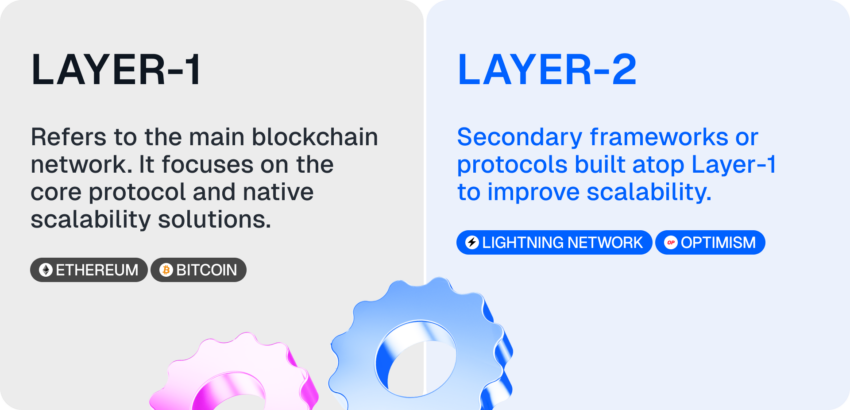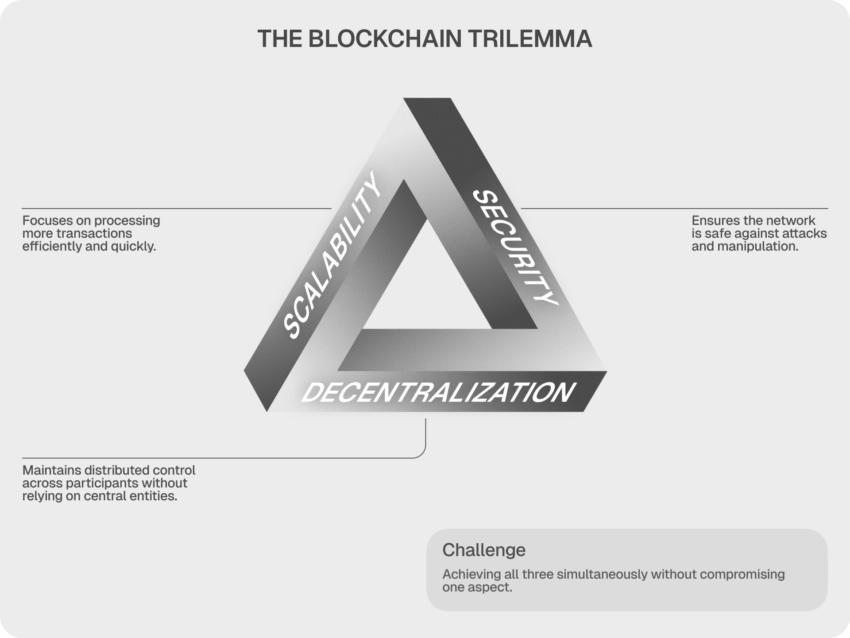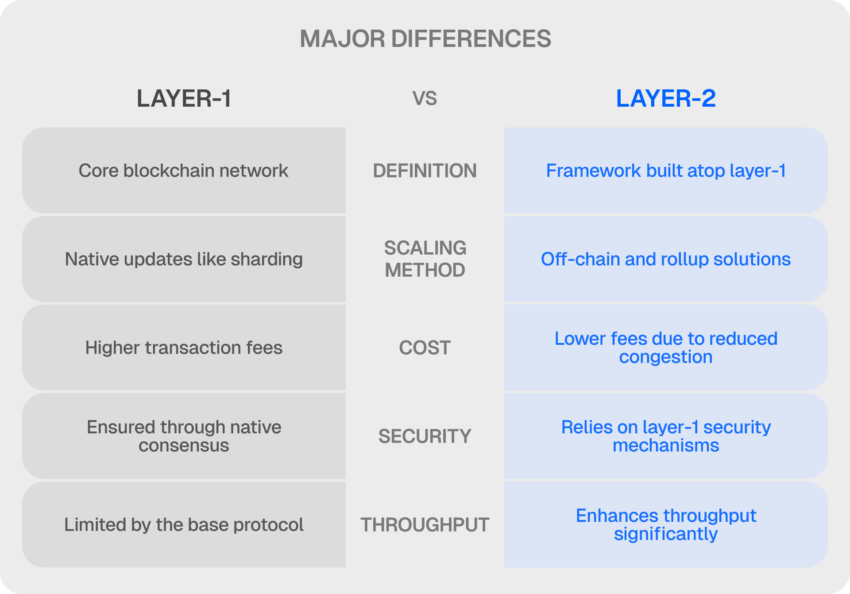As the adoption of blockchain technology continues to grow, scalability has become one of the most critical challenges in the ecosystem. With the rise of decentralized applications (dApps), smart contracts, and increased transaction volumes, blockchains must scale to meet global demand. Two main approaches have emerged to tackle this issue: Layer-1 and Layer-2 scaling solutions.
Layer-1 (L1) refers to the base protocol layer of a blockchain, such as Bitcoin or Ethereum, while Layer-2 (L2) refers to protocols that operate on top of Layer-1 to improve throughput, reduce fees, and alleviate congestion. This guide delves into how both layers contribute to the future of blockchain infrastructure.
In this guide:
- Layer-1 scaling solutions
- Resolving layer-1 limitations
- Layer-2 scaling solutions
- Types of layer-2 solutions
- What is the blockchain trilemma?
- Layer-1 vs. layer-2: major differences
- The future of scaling
- Frequently asked questions
Layer-1 scaling solutions
Layer-1 (L1) scaling involves directly enhancing the base blockchain protocol to boost performance and capacity. This may involve adjusting consensus mechanisms, block sizes, or implementing features like sharding. Key examples of L1 Blockchains include:
- Cardano, Solana, Avalanche: Compete as scalable Layer-1 networks with native design improvements.
- Bitcoin: Optimized for decentralization and security, but limited in throughput.
- Ethereum: Transitioned from Proof-of-Work (PoW) to Proof-of-Stake (PoS) to enhance scalability and energy efficiency.

Layer-1 scaling solutions aim to enhance the foundation of the blockchain layer to facilitate scalability improvements. This presents a variety of ways to enhance the scalability of blockchain networks.
For example, Layer-1 solutions can enable direct modifications to protocol rules to increase transaction capacity and speed. Similarly, layer-1 scaling solutions can provide greater capacity to accommodate more data and users.
Layer-1 scaling techniques
- Block size and block time adjustments: Larger blocks and shorter block intervals allow more transactions per second (TPS), but may impact decentralization.
- Consensus mechanism upgrades: Transitioning from PoW to PoS reduces energy consumption and enables faster finality.
- Sharding: Divides the network state into smaller parts (“shards”) processed in parallel. Utilized by Ethereum 2.0, Zilliqa, Polkadot.
Advantages
- Scalability is the most apparent advantage of layer-1 blockchain solutions. Layer-1 blockchain solutions require protocol modifications for improved scalability.
- A layer-1 blockchain protocol offers decentralization and security with high scalability and economic viability.
- Layer-1 enhances ecosystem development by incorporating new tools, technological advancements, and other variables into the base protocols.
Disadvantages
- Requires hard forks or protocol upgrades
- Slower deployment due to governance and coordination complexity
Resolving layer-1 limitations
Even with upgrades, Layer-1 blockchains face scalability ceilings. Bitcoin’s PoW mechanism limits throughput, and Ethereum experienced high gas fees during congestion. Two notable solutions are:
- Proof-of-Stake (PoS): Replaces miners with validators who stake tokens. Utilized in Ethereum, Cardano, and Tezos.
- Sharding: Breaks the blockchain into parallel-processing shards. Ethereum 2.0 and Polkadot use sharded designs to enhance throughput.
These approaches aim to address the blockchain trilemma: the trade-off between scalability, decentralization, and security.
Improvements to the consensus protocol
Some consensus mechanisms are more efficient than others. PoW is the current consensus protocol on popular blockchain networks like Bitcoin. PoW is secure, but it can be slow. As a result, PoS is the preferred consensus mechanism for most new blockchain networks. This plays a significant role in the layer-1 vs. layer-2 blockchain debate.
PoS systems do not require miners to solve encryption algorithms using significant computing power. Instead, network participants use PoS to process and verify transaction blocks. Ethereum will transition to a PoS consensus algorithm to enhance the network’s capacity while improving decentralization and maintaining network security.
Sharding
Adapted from distributed databases, sharding has emerged as one of the most popular layer-1 scaling solutions. Sharding involves breaking up the state of the entire blockchain network into separate sets of data called “shards”. This approach is more manageable than having all nodes handle the entire network.
The network processes these shards in parallel, enabling the sequential processing of multiple transactions. Additionally, each network node is assigned to a specific shard rather than maintaining a complete copy of the blockchain. Each shard submits proofs to the mainchain and shares addresses, general states, and balances with other shards through cross-shard communication systems. Along with Zilliqa, Qtum, and Tezos, Ethereum 2.0 is a notable blockchain protocol currently exploring shards.
Layer-2 scaling solutions
Layer-2 (L2) refers to technologies built on top of Layer-1 blockchains to enhance scalability without altering the underlying protocol. They process transactions off-chain and post final results back to the base layer, reducing strain on the main network.
The primary goal of layer-2 scaling is to utilize networks or technologies that operate on top of a blockchain protocol. An off-chain protocol or network can help a blockchain network achieve improved scalability and efficiency.
Layer-2 scaling solutions facilitate the delegation of data processing tasks in support architecture more efficiently and flexibly. Consequently, the core blockchain protocol does not encounter congestion, enabling scalability. Key examples of L2 protocols include:
- zkSync, Starknet: Utilize zk-rollups to batch thousands of transactions with cryptographic proofs.
- Lightning Network (Bitcoin): Enables near-instant micropayments through payment channels.
- Optimism & Arbitrum (Ethereum): Use optimistic rollups to scale Ethereum without compromising security.
Advantages
- One of the most significant advantages of a layer-2 solution is that it does not impact the performance or functionality of the underlying blockchain, preserving the network’s overall performance.
- Layer-2 solutions, such as state channels and Lightning Network, speed up the execution of multiple micro-transactions. This is because they do not undergo minor verifications or incur unnecessary fees for such transactions.
Disadvantages
- Layer-2 has a negative impact on blockchain connectivity: A significant issue in blockchain currently is the lack of interconnectivity between different blockchains (for example, being unable to connect with someone on Ethereum while on Bitcoin). This is a significant challenge. Layer-2 can exacerbate this issue by restricting interconnectivity within a network, as layer-2 users are limited to the protocols of the solutions they utilize.
- Privacy and security concerns: Various solutions offer varying levels of security and privacy. However, none of the solutions provide the same level of security as major chains, so it is essential to consider your priorities.
Types of layer-2 solutions
Nested blockchains, state channels, and sidechains are examples of solutions for scaling at the layer-2 level.
Rollups
Rollups batch transactions and submit them as a single proof to L1. The most popular rollup designs are Zero-Knowledge (ZK) and optimistic rollups, each taking a different approach to securing the blockchain’s state.
A zk-rollup is a layer-2 scaling solution that batches transactions off-chain and uses zero-knowledge proofs to verify their validity on-chain, ensuring high security and fast finality with minimal data posted to the base layer.
An optimistic rollup assumes transactions are valid by default and only verifies them if someone submits a fraud proof during a challenge period. The key distinction lies in verification: zk-rollups establish correctness upfront using cryptographic proofs, while optimistic rollups rely on economic incentives and a delay window for fraud detection.
Nested blockchains
Essentially, a nested blockchain is a blockchain within, or on top of, another blockchain. The nested blockchain typically consists of a primary blockchain that sets parameters for a broader network, with executions occurring within an interconnected network of secondary chains.
Multiple blockchain tiers can be built on top of a mainchain, each with its parent-child connection. The parent chain delegates tasks to child chains, which then complete them and return the results to the parent.
Unless dispute resolution is needed, the base blockchain does not participate in the network functions of subsidiary chains. This work distribution model reduces the processing load on the mainchain, significantly improving scalability. The OMG Plasma project exemplifies layer-2 nested blockchain infrastructure, utilized on top of the layer-1 Ethereum protocol.
State channels
A state channel enables bidirectional communication between a blockchain and off-chain transactional channels, enhancing transactional capacity and speed. A state channel does not require validation by layer-1 network nodes but is a network-adjacent resource isolated via multi-signature or smart contract mechanisms.
When transactions are finalized on a state channel, a final “state” of the channel and its changes are written on the underlying blockchain. State channels include Liquid Network, Ethereum’s Raiden Network, Celer, and Bitcoin Lightning. In a trilemma tradeoff, state channels sacrifice some decentralization for greater scalability.
Sidechains
A sidechain is a transactional chain adjacent to a blockchain, commonly used for bulk transactions. Sidechains utilize a consensus mechanism independent of the main chain, allowing users to optimize them for speed and scalability. The main chain’s primary role in a sidechain architecture is to maintain overall security, validate batched transaction records, and resolve disputes.
Sidechains differ from state channels in several key aspects. First, sidechain transactions are not private between participants; they are publicly recorded on the blockchain. Additionally, sidechain security breaches do not impact the main chain or other sidechains. Establishing a sidechain typically requires significant effort as the infrastructure is built from the ground up.
What is the blockchain trilemma?

The scalability trilemma refers to a blockchain’s ability to balance three fundamental properties that constitute its core principles: security, decentralization, and scalability.
The trilemma posits that a blockchain can only possess two of the three properties, never all three simultaneously. Consequently, current blockchain technology will always need to sacrifice one of its core properties for functionality. Bitcoin serves as a prime example; while its blockchain prioritizes decentralization and security, it sacrifices scalability.
Most importantly, no cryptocurrency currently achieves the maximum of all three features. Cryptocurrencies prioritize two or three features at the expense of the remaining one.
Many developers are actively working to address the blockchain trilemma, with implemented techniques and ideas aiming to solve the scalability challenge. Depending on their blockchain implementation level, these concepts and techniques manifest as either layer-1 or layer-2 solutions.
A range of blockchains can process thousands of transactions per second, but they do so by sacrificing decentralization or security. Most blockchains today sacrifice one:
- Ethereum strives to balance all three through layer-2 rollups and sharded PoS.
- Bitcoin prioritizes security and decentralization at the expense of scalability.
- Solana emphasizes scalability and performance while compromising decentralization.
No blockchain has fully resolved the trilemma, but innovations at both Layer-1 and Layer-2 levels continue to push boundaries.
Layer-1 vs. layer-2: major differences

The fundamental distinction between layer-1 and layer-2 scaling solutions provides a solid basis for differentiating them. Here are some key differences between layer-1 and layer-2 scaling solutions for blockchains.
1. Definition
Layer-1 scaling solutions modify the blockchain protocol’s base layer to achieve desired enhancements. For example, block size adjustments can accommodate more transactions, or consensus protocols can be altered to enhance speed and efficiency.
Layer-2 scaling solutions operate as off-chain solutions that share the workload of the primary blockchain protocol. Specific information processing and transaction processing tasks are delegated to layer-2 protocols, networks, or applications by the mainnet of a blockchain protocol. The off-chain protocols or solutions complete the designated task and report the outcome to the main blockchain layer.
2. Method of operation
Layer-1 blockchain networks focus on modifying the core protocol to scale. With layer-1 scaling solutions, blockchain protocols must be changed. Thus, reverting modifications if transaction volume drastically decreases is not immediate.
In contrast, layer-2 scaling solutions function as off-chain solutions independent of the primary blockchain protocol. Off-chain protocols, networks, and solutions only report the essential outcomes required by the immediate blockchain protocol.
3. Types of solutions
For layer-1 blockchain solutions, consensus protocol enhancement and sharding are prominent solutions. Layer-1 scaling involves adjustments to block size or block creation speed to ensure desired functionality.
Regarding blockchain layer-2 scaling solutions, virtually any solutions can be implemented. Any protocol, network, or application can serve as an off-chain layer-2 solution for blockchain networks.
4. Quality
Layer-1 networks serve as the definitive source of information and are ultimately responsible for transaction settlement. Native tokens are used to access network resources on layer-1 networks. Another key feature of layer-1 blockchain networks is innovation in consensus mechanism design.
Layer-2 networks provide the same functionalities as layer-1 blockchains, with added characteristics. For example, layer-2 networks enhance throughput and programmability while reducing transaction costs. Each layer-2 solution remaps transactions to their respective base layer using a unique method.
The future of scaling
Layer-1 and Layer-2 solutions both play crucial roles in scaling blockchain networks. Layer-1 focuses on foundational integrity and protocol-level changes, while Layer-2 delivers practical scalability improvements without burdening the base chain.
Understanding how these layers interact is essential for evaluating modern blockchain ecosystems, whether you’re a developer creating applications or an investor assessing scalability strategies.

